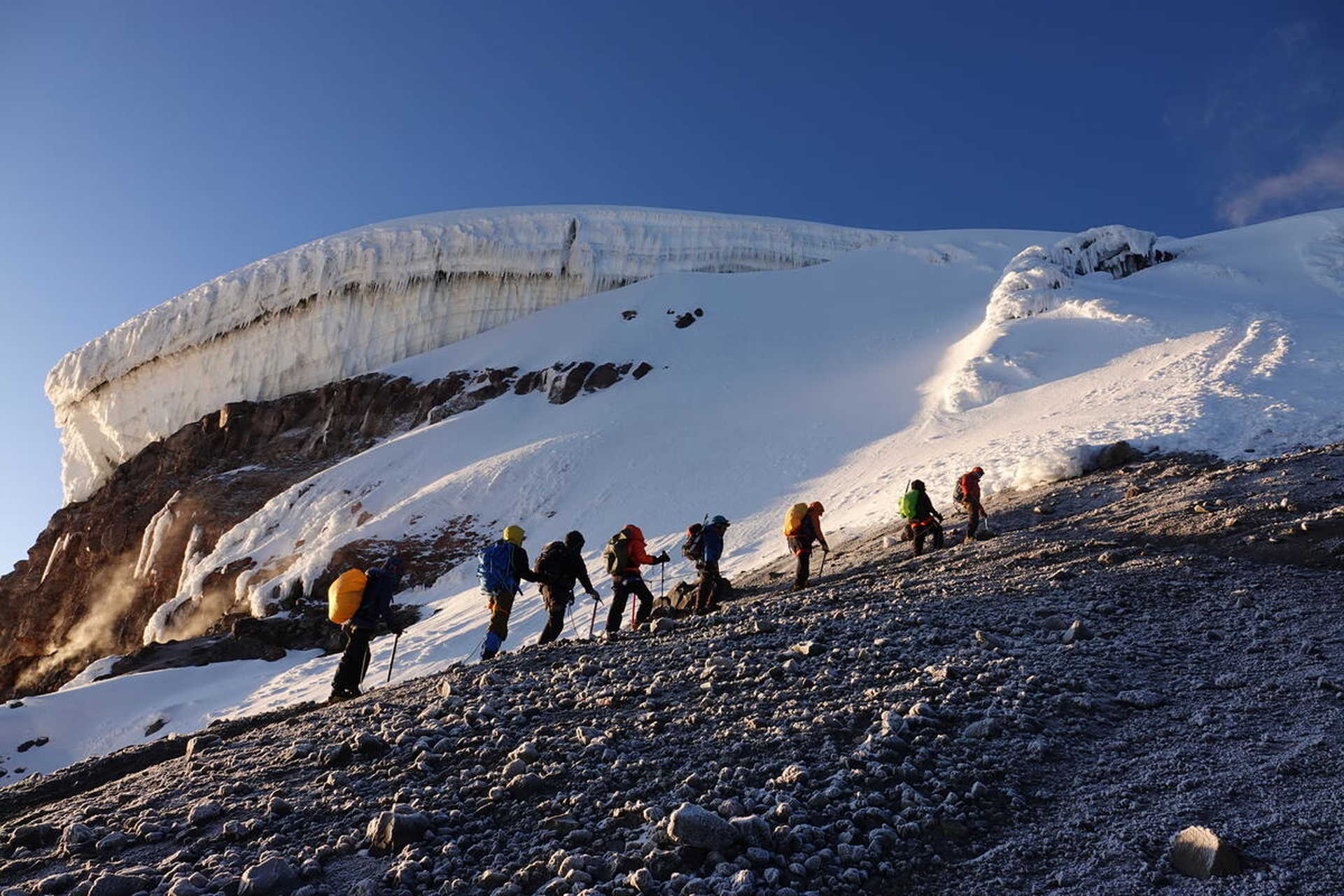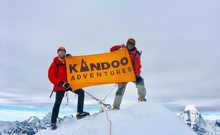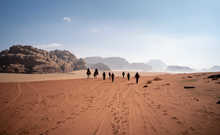Peaks of Ecuador
- Kandoo Summits
- Kandoo Trekking

Contact
our UK team


Welcome to Quito! Declared a UNESCO World Heritage Site in 1978, the city is considered the cultural capital of South America and is located on the equator in a valley at the foothills of the Pichincha volcano. Depending on our arrival time, we can spend today exploring the old town of Quito and the surrounding area. In the evening, one of our trip leaders will meet us at the hotel’s lobby for a welcome briefing at 6pm. This is a time to ask any questions we may have regarding our upcoming adventure.
Explore a truly unique experience in the heart of Quito city and discover it's history from the eyes of the locals, walking around it's narrow streets and visiting the iconic, architectural buildings of the Golden Church, San Francisco Square and the Main Square. We then attend Luis´ local workshop “Cruz Verde”. Luis is a well know artisan whose family has prepared the local candy “Colaciones” for the last 100 years, keeping alive Quito´s timeless tradition. For lunch, we will have the opportunity to sit with the locals and enjoy a tasty meal, freshly prepared using local products and flavours.
We'll leave Quito this morning by car, heading south for the Avenida de los Volcanoes. During this drive we enjoy beautiful views of the typical Ecuadorian landscape, villages and highlands. The ascent of this extinct volcano will take us around 4 hours. Once on the top, we'll have some lunch at an incredible viewpoint which looks out over Cotopaxi and the other nearby volcanoes. We conclude our day at Termas de Papallacta and recharge in the volcanic hot springs, high up in the midst of the Andes.
Today we wake early and are out by 7am to visit the Virgin of Papallacta before enjoying a scenic trek up through the rolling mountains beyond. From the top, we are treated to a beautiful Andean panorama, where gentle peaks are interspersed with hidden lagoons. The Agua y Vida Trek is part of the Cayambe Coca National Park and the higher levels of rainfall in this region provide a natural water reservoir that feeds the city of Quito. We visit the lagoon areas of the Negra, Parcacocha, and Miraculous Waterfalls before returning to Termas de Papallacta for the night.
Another day of acclimatisation and training awaits us today. Also known as "Papallacta Peak", this trek ascends to just over 4300 meters, within the Cayambe-Coca reserve, along a path lined with alpine shrubbery. Throughout our trek we are surrounded by small lakes, lagoons and natural hot springs that we can enjoy to break up the day.
After breakfast, we will take a private transfer to the Ruales-Oleas-Berge Hut, that is nestled on the lower scree slopes of Cayambe. Here we partake in a glacier training, to prepare us for our summit of Cayambe volcano. Our guide will run through snow and ice climbing techniques, climbing in a roped team on a glacier and crevasse rescue. We then return to our guesthouse this evening to prepare our bags for the following days climb.
After breakfast, we continue with our glacier training, going over ice and snow anchorages, rappel and crevasse self-rescue. We then retreat to the Refuge to prepare our equipment for the next day’s ascent and get an early night.
Around midnight we will get up, have a snack and set off up the route to the summit of Cayambe. The path begins by scrambling over large boulders, before steepening to the base of the glacier. Here we will rope up and get out our axes and crampons before beginning the slow plod, up through rocky snow fields, that give way to smooth glacier. It will take us around 7 hours to reach the summit, arriving for sunrise. If we are lucky we may even be treated to a glorious cloud inversion, before beginning the descent back to the Refuge. This will take us approximately 4 hours and once back, we hop into our vehicle and head on to Otavolo, where we can rest and recuperate after our first full-on day.
Today we will head into Otavalo to visit it's colourful, indigenous market where we’ll have the chance to try out our haggling skills and buy some souvenirs to remember our trip. Then we will continue South along the Panamerican highway to Cotopaxi National Park, where we check in to our hotel for tonight.
This morning we will drive to the carpark at the base of Cotopaxi, which lies at 4864m. From there, we will trek for another hour, ochre hues of volcanic ash underfoot, before reaching the Jose Ribas Refuge (4862m). Here we'll do some recapping on the glacier before we have supper and prepare for our ascent the following day.
Rising once again at midnight, we begin our climb, which will take us around 7 hours. The hiking on Cotopaxi is much less technical than that on Cayambe, making it more accessible and therefore more popular. Upon reaching the top, we'll have a marvellous view of the snow covered crater and surrounding peaks; with a diameter of 800m, this sulfuric hollow provides a unique summit experience. Returning to the refuge by midday we head to our hotel, not far from the base of the volcano.
Early this morning, we will drive through valleys and farming villages to reach Chimborazo, the highest mountain in Ecuador with an elevation of 6310m; whose summit is also the furthest point from the centre of the earth on the entire planet. On a clear day, the majestic peak of Chimborazo dominates the view of the surrounding area.
Upon arrival in this region, we will embark on a short 1 km acclimatisation hike to reach an elevation of 5000m where the glacier begins. We keep our eyes peeled for the animals that inhabit this volcanic wonderland such as the Andean condor, Cara-Cara, Hummingbirds, and the timid Vicuñas. Once extinct in Ecuador, Vicuñas have been reintroduced and are now a protected species; although much shyer, they bear a striking resemblance to their close relatives - alpacas and llamas.
This morning we are transferred to the Hermanos Carrel refuge at 4800m where we begin our climb. From the refuge, we ascend a steep scree slope on mixed terrain, picking our way between larger boulders and loose sections, with the Thielman glacier towering over us above. Depending on weather we may need to use our crampons for some sections of this. We then traverse towards a col, at 5300m, next to which proudly stands a rocky outcrop called ‘El Castillo’ or 'the castle'. Dropping just below this we reach our high camp at 5300m, where a delicious hot tea awaits us. Here we will have the opportunity to relax and prepare the equipment for the ascent, dinner and rest.
Shortly after midnight, we get up and have a cup of hot tea and a snack. Well prepared and well acclimatized, we begin the ascent to the highest peak in Ecuador. From our camp, we climb along the glaciated ridgeline, that becomes increasingly wider as we get closer to the lower summit of Chimborazo. Just before this summit, the ridge steepens to around 35 degrees and offers up some icy sections and crevasses, increasing the challenge somewhat. We then traverse across several flat topped mushrooms and on to Veintimilla summit (6310m).
From Veintimilla summit, it is approximately 1 hours climb, wading through a snow filled glacial trough, to reach Whymper's summit at 6310m. Standing atop the summit, we take in the incredible views, before making our descent back down the way we have come. The further along the day it is, the higher likelihood of crevasse danger in the glacial trough between the two summits, so dependant on the progress of the group, our guide may choose to descend from Veintimilla instead.
Today we will take our private transfer back to Quito and have a leisurely evening in the city or our hotel.
Today we are wished a “buen viaje” and transferred to the airport for our onwards flights.
This trip is given a tough challenge rating because it is one of the hardest challenges we offer. With 3 glacial peaks over 5000m to summit, a significant amount of grit and determination is going to be necessary to complete this adventure. Although non of the peaks have any technical climbing, there will be sections of scrambling and areas where you will be roped together for safety.
In Ecuador, expect to try a whole host of exotic foods and spices as we travel through various different regions. From the traditional foods of toasted corn and stuffed meats, to the more trendy spicy empanadas and citrus-infused cerviche the cuisine here is delicious! The guesthouses and smaller hotels we stay in will provide hearty, generous meals and in the larger cities you will have the choice of local restaurants or hotel favourites. Drinks are not included with dinner, so please make sure you have some cash with you for any drinks you may want. Please also be aware that hotels in small villages and town may not accept card payments.
Water in Ecuador isn't necessarily safe to drink. We provide
water bottle refills every morning and evening from a filtered water source, if
you think you will need to refill your bottle during the day, we suggest you
bring a water purification system. We do not encourage the purchase of
single use plastic bottles so we would recommend either a charcoal filter or
purification tablets to make your water safe to drink.
On this trip we will stay in a range of accommodation. For some of the nights in the valleys between mountain days we will be staying in family run guesthouses or Hosteria. These are small, simple hotels with basic twin or double rooms. Most of the guesthouses we use have en-suite rooms however, dependant on the location, some have shared bathrooms.
Whilst on the volcanoes, we spend nights in mountains
refuges and camping. Mountain refuges are basic mixed gender dormitory style
rooms, with shared amenities such as dining area and toilet facilities. These
are not designed to be luxury quarters band we recommend bringing ear plugs
particularly for these nights. The beds all have thick mattresses and we will
provide you with a warm, 4 season Husky sleeping bag as temperatures can reach -15 in
the huts. For your night camping at "El Castillo" on Chimborazo, you will
be staying in high altitude mountain tents, to ensure you stay warm, dry and
comfortable. Please bear in mind, these are proper mountain tents, designed to
cope with extreme conditions so don’t expect to be able to stand up and walk
around inside! We will provide you with a sleeping mat and sleeping bag for
your night camping. You will take your meals in a group dining tent.
Your bags will be transported by vehicle between locations,
and you will carry a smaller 30-40L daysack on your treks each day.
On your Chimborazo climb, you will leave your main bag in
the vehicle, which will stay at the refuge. For your climb to Castle Camp, on
to the summit, then descending back to the refuge, you will be carrying all
your personal equipment in your daysack - this will include some warm layers,
snacks, camera, basic toiletries and water. Everything else will be provided
for you at Castle Camp.
For US travellers, there are direct flights to Mariscal Sucre airport with American Airlines, LATAM and Delta from Miami and Atlanta. They also offer services from other main hubs such as New York, San Francisco and Dallas, via Miami. Copa Airlines also offer a service to Quito via Panama from San Francisco and Los Angeles.
Guides: US$10 – 20 per trekker
per day
Drivers: US$5 – 10 per trekker
per day
Specialist mountain guides: US$50
per person per climb
Specialist mountain guides will join you for the climbs. Any tip made to them should
be made after your climb as you will leave them after the climb has ended.
Tips should be made in US Dollars
and bills should be crisp, untorn and less than 10 years old.
For this trip you will need specialist climbing equipment. We provide the following equipment as part of your trip package. This equipment is regularly checked and updated to meet regulations.
UPPER BODY
LEGS
FEET
CLIMBING GEAR
OTHER ACCESSORIES
| From | To | Price | Availability | Book | Enquire |
|---|---|---|---|---|---|
| 13/06/2026 | 28/06/2026 | £2,999 $3,899 |
Available
|
Book now | Enquire now |
| 04/07/2026 | 19/07/2026 | £2,999 $3,899 |
Available
|
Book now | Enquire now |
| 01/08/2026 | 16/08/2026 | £2,999 $3,899 |
Available
|
Book now | Enquire now |
| 12/06/2027 | 27/06/2027 | £3,099 $4,029 |
Available
|
Book now | Enquire now |
| 03/07/2027 | 18/07/2027 | £3,099 $4,029 |
Available
|
Book now | Enquire now |
| 07/08/2027 | 22/08/2027 | £3,099 $4,029 |
Available
|
Book now | Enquire now |
Want to ask us a question or book a private trip? Don't hesitate to contact us!
Contact us